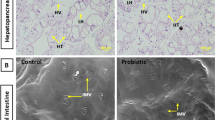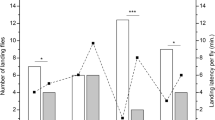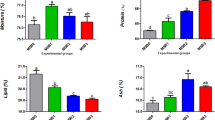Abstract
The gut bacteria can provide nutrition for the host, and regulate host physiological functions and host behavior. In this study, we specifically examined the important roles of free amino acids in the gut microbiota-host interaction. Bumblebees were treated with different concentrations of antibiotics (ampicillin combined with low/high concentrations of tetracycline). Then the effect of antibiotic treatments on the host body weight, gut microbiota, and the free amino acid profiles in the hindgut, hemolymph and brain of bees was evaluated. The results showed that antibiotic treatments resulted in a significant decrease in the host body weight at 11 days of age, the total bacterial load and the abundance of Bifidobacterium bohemicum and Gilliamella apicola in the bumblebee’s hindgut. Additionally, the higher the concentration of antibiotics (tetracycline), the greater their impact on the body weight and intestinal microbiota of bumblebees. Further, we found that antibiotic treatments caused changes of free amino acids in different tissues, especially in the hindgut and hemolymph, including particularly the decrease of several types of essential amino acids and branched-chain amino acids. Our results suggest that the gut microbiota may modulate the host growth via specific essential amino acids and branched-chain amino acids, which further reveals the crucial roles of free amino acids in the gut microbiota-host interplay.





Similar content being viewed by others
Data availability statement
The data generated or analysed during this study are included in this article or are available from the corresponding author on reasonable request.
References
Abbott NJ, Ronnback L, Hansson E (2006) Astrocyte-endothelial interactions at the blood-brain barrier. Nat Rev Neurosci 7(1):41–53
Abubucker S, Segata N, Goll J, Schubert AM, Izard J, Cantarel BL, Rodriguez-Mueller B, Zucker J, Thiagarajan M, Henrissat B, White O, Kelley ST, Methe B, Schloss PD, Gevers D, Mitreva M, Huttenhower C (2012) Metabolic reconstruction for metagenomic data and its application to the human microbiome. Plos Comput Biol 8(6):e1002358
Agus A, Planchais J, Sokol H (2018) Gut microbiota regulation of tryptophan metabolism in health and disease. Cell Host Microbe 23(6):716–724
Arnoriaga-Rodriguez M, Mayneris-Perxachs J, Burokas A, Contreras-Rodriguez O, Blasco G, Coll C, Biarnes C, Miranda-Olivos R, Latorre J, Moreno-Navarrete JM, Castells-Nobau A, Sabater M, Palomo-Buitrago ME, Puig J, Pedraza S, Gich J, Perez-Brocal V, Ricart W, Moya A, Fernandez-Real X, Ramio-Torrenta L, Pamplona R, Sol J, Jove M, Portero-Otin M, Maldonado R, Fernandez-Real JM (2020) Obesity impairs short-term and working memory through gut microbial metabolism of aromatic amino acids. Cell Metab 32(4):548
Boado RJ, Li JY, Nagaya M, Zhang C, Pardridge WM (1999) Selective expression of the large neutral amino acid transporter at the blood-brain barrier. Proc Natl Acad Sci USA 96(21):12079–12084
Bonilla-Rosso G, Engel P (2018) Functional roles and metabolic niches in the honey bee gut microbiota. Curr Opin Microbiol 43:69–76
Chang CH, Lin CH, Lane HY (2020) D-glutamate and gut microbiota in Alzheimer’s disease. Int J Mol Sci 21(8):2676
Cryan JF, Dinan TG (2012) Mind-altering microorganisms: the impact of the gut microbiota on brain and behaviour. Nat Rev Neurosci 13(10):701–712
Cryan JF, O’Riordan KJ, Cowan CSM, Sandhu KV, Bastiaanssen TFS, Boehme M, Codagnone MG, Cussotto S, Fulling C, Golubeva AV, Guzzetta KE, Jaggar M, Long-Smith CM, Lyte JM, Martin JA, Molinero-Perez A, Moloney G, Morelli E, Morillas E, O’Connor R, Cruz-Pereira JS, Peterson VL, Rea K, Ritz NL, Sherwin E, Spichak S, Teichman EM, van de Wouw M, Ventura-Silva AP, Wallace-Fitzsimons SE, Hyland N, Clarke G, Dinan TG (2019) The microbiota-gut-brain axis. Physiol Rev 99(4):1877–2013
de Gavelle E, Huneau JF, Bianchi CM, Verger EO, Mariotti F (2017) Protein adequacy is primarily a matter of protein quantity, not quality: modeling an increase in plant: animal protein ratio in French adults. Nutrients 9(12):1333
Dillon RJ, Vennard CT, Buckling A, Charnley AK (2005) Diversity of locust gut bacteria protects against pathogen invasion. Ecol Lett 8(12):1291–1298
Dodd D, Spitzer MH, Van Treuren W, Merrill BD, Hryckowian AJ, Higginbottom SK, Le A, Cowan TM, Nolan GP, Fischbach MA, Sonnenburg JL (2017) A gut bacterial pathway metabolizes aromatic amino acids into nine circulating metabolites. Nature 551(7682):648
Engel P, Martinson VG, Moran NA (2012) Functional diversity within the simple gut microbiota of the honey bee. Proc Natl Acad Sci USA 109(27):11002–11007
Fernstrom JD (2013) Large neutral amino acids: dietary effects on brain neurochemistry and function. Amino Acids 45(3):419–430
Hammer TJ, Le E, Martin AN, Moran NA (2021) The gut microbiota of bumblebees. Insectes Soc 68(4):287–301
Han SW, Chee KM, Cho SJ (2015) Nutritional quality of rice bran protein in comparison to animal and vegetable protein. Food Chem 172:766–769
Jing TZ, Qi FH, Wang ZY (2020) Most dominant roles of insect gut bacteria: digestion, detoxification, or essential nutrient provision? Microbiome 8(1):38
Joshi MA, Jeoung NH, Obayashi M, Hattab EM, Brocken EG, Liechty EA, Kubek MJ, Vattem KM, Wek RC, Harris RA (2006) Impaired growth and neurological abnormalities in branched-chain alpha-keto acid dehydrogenase kinase-deficient mice. Biochem J 400:153–162
Kelly JR, Kennedy PJ, Cryan JF, Dinan TG, Clarke G, Hyland N (2015) Breaking down the barriers: the gut microbiome, intestinal permeability and stress-related psychiatric disorders. Front Cell Neurosci 9:392
Kesnerova L, Mars RAT, Ellegaard KM, Troilo M, Sauer U, Engel P (2017) Disentangling metabolic functions of bacteria in the honey bee gut. Plos Biol 15(12):e2003467
Kwong WK, Engel P, Koch H, Moran NA (2014) Genomics and host specialization of honey bee and bumble bee gut symbionts. Proc Natl Acad Sci USA 111(31):11509–11514
Li L, Solvi C, Zhang F, Qi ZY, Chittka L, Zhao W (2021) Gut microbiome drives individual memory variation in bumblebees. Nat Commun 12(1):6588
Lordan C, Thapa D, Ross RP, Cotter PD (2020) Potential for enriching next-generation health-promoting gut bacteria through prebiotics and other dietary components. Gut Microbes 11(1):1–20
Maier L, Pruteanu M, Kuhn M, Zeller G, Telzerow A, Anderson EE, Brochado AR, Fernandez KC, Dose H, Mori H, Patil KR, Bork P, Typas A (2018) Extensive impact of non-antibiotic drugs on human gut bacteria. Nature 555(7698):623
Martinson VG, Moy J, Moran NA (2012) Establishment of characteristic gut bacteria during development of the honeybee worker. Appl Environ Microbiol 78(8):2830–2840
Moran NA (2015) Genomics of the honey bee microbiome. Curr Opin Insect Sci 10:22–28
Neis E, Dejong CHC, Rensen SS (2015) The role of microbial amino acid metabolism in host metabolism. Nutrients 7(4):2930–2946
Pietz J, Kreis R, Rupp A, Mayatepek E, Rating D, Boesch C, Bremer HJ (1999) Large neutral amino acids block phenylalanine transport into brain tissue in patients with phenylketonuria. J Clin Investig 103(8):1169–1178
Raymann K, Shaffer Z, Moran NA (2017) Antibiotic exposure perturbs the gut microbiota and elevates mortality in honeybees. Plos Biol 15(3):e2001861
Sampson TR, Debelius JW, Thron T, Janssen S, Shastri GG, Ilhan ZE, Challis C, Schretter CE, Rocha S, Gradinaru V, Chesselet MF, Keshavarzian A, Shannon KM, Krajmalnik-Brown R, Wittung-Stafshede P, Knight R, Mazmanian SK (2016) Gut microbiota regulate motor deficits and neuroinflammation in a model of Parkinson’s disease. Cell 167(6):1469
Sethi V, Kurtom S, Tarique M, Lavania S, Malchiodi Z, Hellmund L, Zhang L, Sharma U, Giri B, Garg B, Ferrantella A, Vickers SM, Banerjee S, Dawra R, Roy S, Ramakrishnan S, Saluja A, Dudeja V (2018) Gut microbiota promotes tumor growth in mice by modulating immune response. Gastroenterology 155(1):33
Sun YK, He ZL, Li JJ, Gong SS, Yuan SZ, Li T, Ning NZ, Xing L, Zhang LY, Chen FH, Li Z, Wang JX, Luo DY, Wang H (2021) Gentamicin induced microbiome adaptations associate with increased BCAA levels and enhance severity of influenza infection. Front Immunol 11:608895
Thompson SN (2003) Trehalose - the insect “blood” sugar. Adv Insect Physiol (s J Simpson) 31:205–285
Torrallardona D, Harris CI, Coates ME, Fuller MF (1996) Microbial amino acid synthesis and utilization in rats: incorporation of N-15 from (NH4Cl)-N-15 into lysine in the tissues of germ-free and conventional rats. Br J Nutr 76(5):689–700
Uribe-Herranz M, Rafail S, Beghi S, Gil-de-Gomez L, Verginadis I, Bittinger K, Pustylnikov S, Pierini S, Perales-Linares R, Blair IA, Mesaros CA, Snyder NW, Bushman F, Koumenis C, Facciabene A (2020) Gut microbiota modulate dendritic cell antigen presentation and radiotherapy-induced antitumor immune response. J Clin Investig 130(1):466–479
Usuda K, Kawase T, Shigeno Y, Fukuzawa S, Fujii K, Zhang HL, Tsukahara T, Tomonaga S, Watanabe G, Jin WZ, Nagaoka K (2018) Hippocampal metabolism of amino acids by L-amino acid oxidase is involved in fear learning and memory. Sci Rep 8:11073
Wang W, Jiang SJ, Xu CC, Tang LL, Liang Y, Zhao Y, Zhu GX (2022) Interactions between gut microbiota and Parkinson’s disease: the role of microbiota-derived amino acid metabolism. Front Aging Neurosci 14:976316
Waters JL, Ley RE (2019) The human gut bacteria Christensenellaceae are widespread, heritable, and associated with health. BMC Biol 17(1):83
Wu SY, Zuo JH, Cheng Y, Zhang Y, Zhang ZS, Wu MJ, Yang Y, Tong HB (2021) Ethanol extract of Sargarsum fusiforme alleviates HFD/STZ-induced hyperglycemia in association with modulation of gut microbiota and intestinal metabolites in type 2 diabetic mice. Food Res Int 147:110550
Yang WJ, Cong YZ (2021) Gut microbiota-derived metabolites in the regulation of host immune responses and immune-related inflammatory diseases. Cell Mol Immunol 18(4):866–877
Yudkoff M (1997) Brain metabolism of branched-chain amino acids. Glia 21(1):92–98
Zhang SH, Zeng XF, Ren M, Mao XB, Qiao SY (2017) Novel metabolic and physiological functions of branched chain amino acids: a review. J Anim Sci Biotechnol 8:10
Zheng H, Nishida A, Kwong WK, Koch H, Engel P, Steele MI, Moran NA (2016) Metabolism of toxic sugars by strains of the bee gut symbiont Gilliamella apicola. Mbio. https://doi.org/10.1128/mBio.01326-16
Zheng H, Perreau J, Powell JE, Han BF, Zhang ZJ, Kwong WK, Tringe SG, Moran NA (2019) Division of labor in honey bee gut microbiota for plant polysaccharide digestion. Proc Natl Acad Sci USA 116(51):25909–25916
Zheng H, Powell JE, Steele MI, Dietrich C, Moran NA (2017) Honeybee gut microbiota promotes host weight gain via bacterial metabolism and hormonal signaling. Proc Natl Acad Sci USA 114(18):4775–4780
Acknowledgements
This work was supported by National Natural Science Foundation of China (no. 32100385) and Natural Science Foundation of Jiangsu Province, China (no. BK201 90598) to L.L., and by the National Key Research and Development Program of China (No.2017YFC1601704), the National Natural Science Foundation of China (No. 1522044, 31671909 and 31772034), the Program of the Jiangsu Key Laboratory of Advanced Food Manufacturing Equipment & Technology (No. FMZ201904), the National First-Class Discipline Program of Food Science and Technology (No. JUFSTR20180205) to W.Z.
Author information
Authors and Affiliations
Contributions
RC, LL and WZ conceived the study; RC performed the experiments; RC and LL analyzed the data; RC, LL and WZ wrote the manuscript.
Corresponding authors
Ethics declarations
Conflict of interest
All authors declare no competing interests.
Additional information
Handling editor: F. Albericio.
Publisher's Note
Springer Nature remains neutral with regard to jurisdictional claims in published maps and institutional affiliations.
Rights and permissions
Springer Nature or its licensor (e.g. a society or other partner) holds exclusive rights to this article under a publishing agreement with the author(s) or other rightsholder(s); author self-archiving of the accepted manuscript version of this article is solely governed by the terms of such publishing agreement and applicable law.
About this article
Cite this article
Chen, R., Li, L. & Zhao, W. Antibiotics-induced dysbiosis in gut microbiota affects bumblebee health via regulating host amino acid metabolism. Amino Acids 55, 519–528 (2023). https://doi.org/10.1007/s00726-023-03247-8
Received:
Accepted:
Published:
Issue Date:
DOI: https://doi.org/10.1007/s00726-023-03247-8




